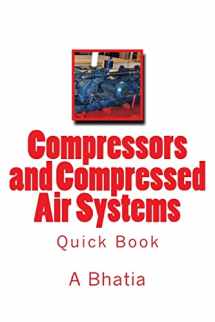
Compressors and Compressed Air Systems: Quick Book
ISBN-13:
9781505391787
ISBN-10:
1505391784
Author:
A Bhatia
Publication date:
2014
Publisher:
CreateSpace Independent Publishing Platform
Format:
Paperback
130 pages
FREE US shipping
Book details
ISBN-13:
9781505391787
ISBN-10:
1505391784
Author:
A Bhatia
Publication date:
2014
Publisher:
CreateSpace Independent Publishing Platform
Format:
Paperback
130 pages
Summary
Compressors and Compressed Air Systems: Quick Book (ISBN-13: 9781505391787 and ISBN-10: 1505391784), written by authors
A Bhatia, was published by CreateSpace Independent Publishing Platform in 2014.
With an overall rating of 4.0 stars, it's a notable title among other
books. You can easily purchase or rent Compressors and Compressed Air Systems: Quick Book (Paperback) from BooksRun,
along with many other new and used
books
and textbooks.
And, if you're looking to sell your copy, our current buyback offer is $0.3.
Description
Compressed air has many applications in industry. Delivering compressed air to a manufacturing facility is an expensive operation and it requires costly equipment that consumes significant amounts of electricity and needs frequent maintenance. Roughly 80 to 90 percent of the electricity used to operate compressed air systems is converted to low-temperature waste heat. This lost energy can quickly add up, each year costing individual facilities as much as double the purchase and installation cost (first-cost) of the entire system. The ideal time to think about your compressed air system is before it is installed. Air Compressors deserve independent treatment due to many reasons. There is a wider choice of different types of compressor designs each operating at different efficiencies and suitable for specific application. The type of compressor decided upon has direct implications on the lifetime energy costs. Also the decision as to a single compressor of large capacity versus multi-compressor installation where each compressor has a smaller capacity than the demand influences the possible energy savings considerably. This 6 -hour Quick Book Course provides comprehensive information on the compressed air systems. This course is relevant to anyone needing to know more about compressed air production and use, relevant health and safety issues, legislation and energy efficiency. Previous knowledge of the subject is not required. The book includes a multiple type quiz comprising 30 questions at the end. Learning Objective At the conclusion of this course, the student will: • Understand various types of compressors; their applications, advantages and limitations; • Understand various types of system controls - their pros and cons; • Understand how the control systems are matched to the needs of the users; • Understand the key components of compressed air system and learn how each component function; • Understand the air storage, air drying, piping, filtration and air cleaning methods; • Understand the limits of dew point suppression in refrigerant and desiccant dryers; • Understand the different types of filters and how coalescing filters benefit in removal of lubricant and moisture; • Understand the difference between SCFM, ICFM and ACFM; • Understand the pros and cons of single loop verses ring main systems; • Understand how to quantify and select appropriate compressor for base and trim demand; • Understand what features to specify and what information to seek when making a compressed air proposal; • Understand the compressed air system assessment procedure and energy audit methodology; • Understand the common losses in compressed air systems and the ways to conserve energy; • Understand the routine maintenance schedule for air compressors; • Learn a generic checklist for energy efficiency in compressed air system; • Understand the engineering formulae and technical relationship between compressor motor power-draw and process variables; and • Learn by example the method for evaluating compressed air costs.


We would LOVE it if you could help us and other readers by reviewing the book
Book review

Congratulations! We have received your book review.
{user}
{createdAt}
by {truncated_author}


